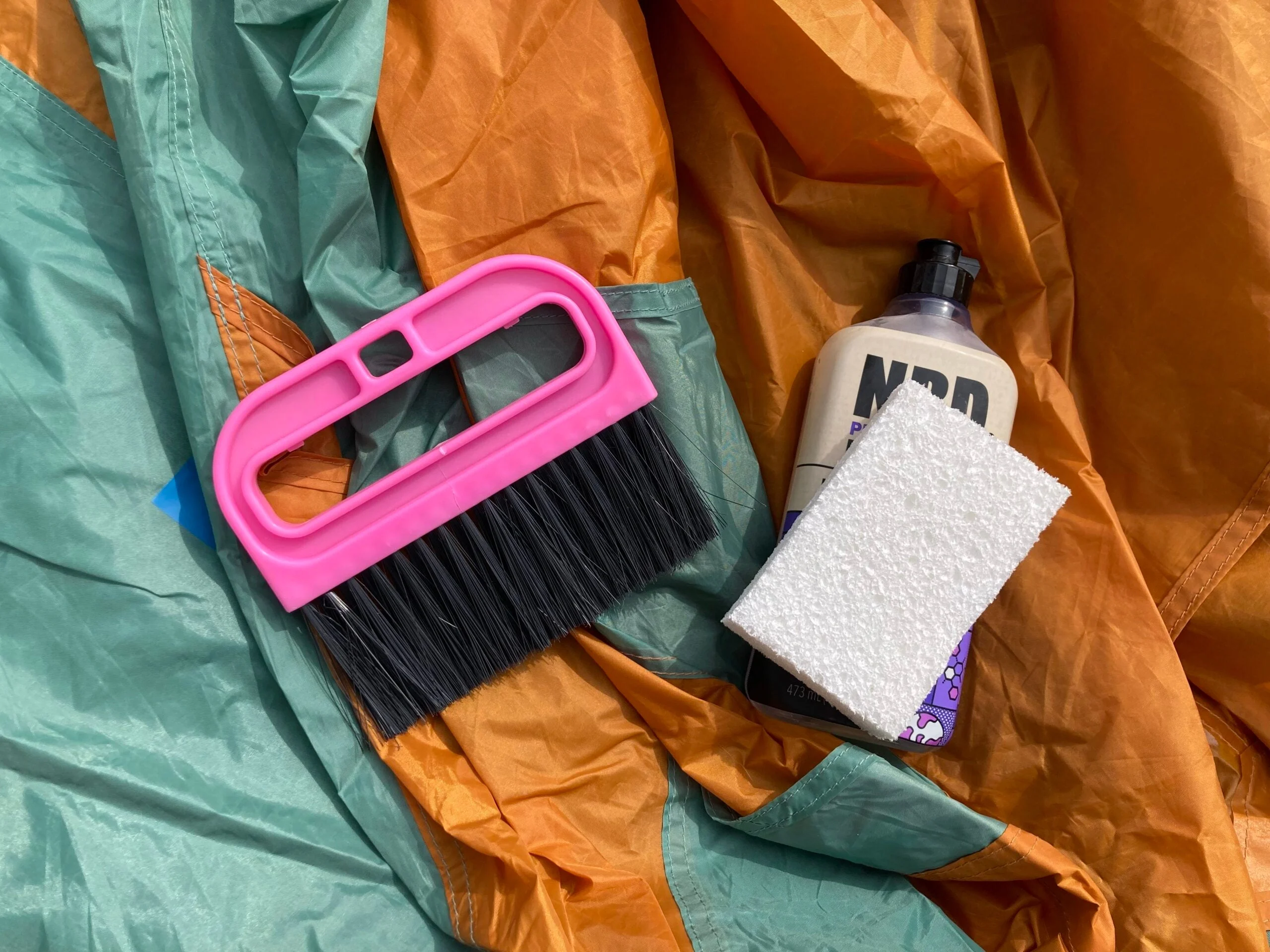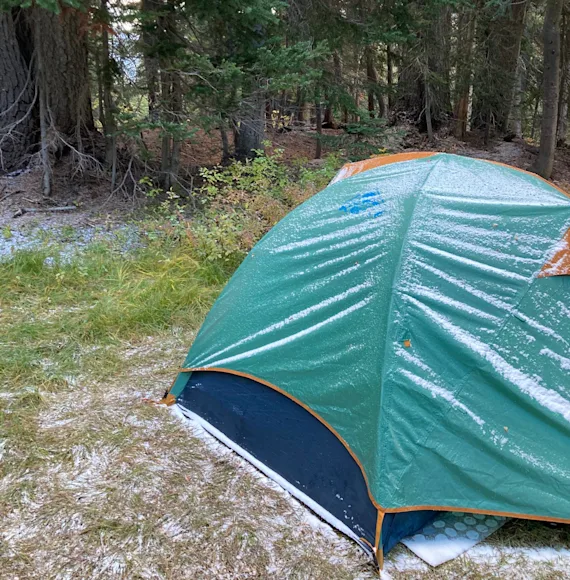_We may earn revenue from the products available on this page and participate in affiliate programs. Learn more ›
_
We talk a lot about repairs to improve gear longevity, but general gear maintenance, care, and cleaning are also key to keeping your gear in commission for as long as possible. However, knowing how to clean your gear isn’t always as easy as tossing it in the wash.
With products like tents, keeping them clean makes your user experience much better. With time, the tent material will start to collect sand, dirt, and other forms of grime. The build-up of dirt, sweat, body oils and general trail grime might stink, but it can also lead to premature breakdown of fabrics, cutting the lifespan of your tent down.
Anytime you are cleaning a piece of outdoor gear, always read the manufacturer’s recommendations and washing instructions. Most of the cleaning options below will work on a wide range of tents, but following the manufacturer’s instructions prevents gear from being damaged during the cleaning process.
How to Wash a Tent
Getting into the yearly habit of washing your tent and other outdoor gear is a great way to prolong their lifespan and improve their water-resistant capabilities. While you can do this every spring when you take your gear out of storage, it may be better to wash things like tents before storing them away all winter. That way, they are not sitting in storage filled with last season’s dirt, deteriorating the fabric.
If you do choose to wash the tent before storing it, be sure that the tent is completely dry before packing it away. Even a tiny amount of moisture can cause mold and mildew issues, making it even harder to clean in the future.
For the vast majority of tents, it is recommended that you wash them by hand in a large tub or sink. As mentioned, always follow manufacturer-specific instructions for washing.
Before you get started, gather the materials:
Mild soap (fragrance-free dish soap or Dr. Bronner’s Castile Liquid Soap
works)
Sponge or cloth
Optional: soft-bristled brush or broom
When washing a tent, using an outdoor gear cleaner is not completely necessary. You can get away with just using a mild fragrance-free soap, but never use things like detergent, pre-soaking laundry products, bleach, spot cleaners, or other abrasive cleaners. The benefit of many outdoor textile cleaners
is that they may include a waterproofing solution, and they’re designed specifically for this purpose.
You can use a large sink, bathtub, or even an empty storage bin during the washing process. You just need something large enough to submerge the entire tent and rainfly in water. Using cold or lukewarm water is recommended to protect material integrity.

Mild dish soap and a sponge work well for most tent cleans. Use a brush to dust off loose dirt before washing.
How to Clean Your Tent—Step by Step
Once you’ve gathered all the necessary materials, get your tent and head outside. Open it up to shake it and brush it off to remove any loose debris before washing. You can use a soft-bristled broom or brush to clean out the interior and brush off loose dirt.
If certain areas of the tent are especially dirty, spot clean those before washing the entire tent. Do this by wetting the area with a sponge and working some of the mild soap into that spot.
Fill a tub with cold or lukewarm water and some mild soap or the cleaner of your choice. Follow the directions on the cleaner to see how much to add to the water solution.
There is no need to rinse the soap off of the spot cleaning areas, but you may want to unzip the tent doors and turn it inside out.
Submerge the tent and the rainfly into the water and cleaning solution mixture and let sit for a few minutes before agitating and swirling the material around by hand.
Although the cleaner you chose may have different timelines, if you use a mild soap mixture, let the tent sit in the water for around 20 minutes, agitating and swirling the material around occasionally.
Remove the tent from the water. Squeeze to remove excess water, but do not twist. If the water is visibly dirty, drain the water and repeat the soaking process until the water is close to clear.
Once the tent is clean to your satisfaction, drain and refill the tub with clean water. Rinse the soap out thoroughly. It may take a few rinses to do this.
Hang dry the tent. Do not use a dryer. If you do not have a place you can hang the tent to dry, set the tent up in a cool, shaded area to dry. If you hang it, avoid resting it on any sharp edges and hanging it by the corners.
The tent should be completely dry before storing. The drying process may take several days, and the tent will need to be flipped occasionally to make sure it drys fully.
Storing a tent with any moisture can lead to mold and mildew. Removing mold is exceptionally difficult, and you may not be able to do it effectively, leaving it with a foul odor. The best thing you can do is prevent mold from having a chance to grow. If you’ve had the unfortunate luck of having a moldy tent, try using an enzyme cleaner
and follow the directions provided.
Other Tent and Pack Care Tips
You shouldn’t need to deep clean your tent more than once a year. Do occasional spot cleans and let the tent air out after trips. The frequency of use can also impact how often you wash the tent materials.
You may need to use other cleaning methods for different tent parts like the poles and the zippers. Most tent pole care
is relatively simple, and using a damp rag will do the trick of removing any dust or dirt.
If the tent zippers are not running smoothly or getting stuck because they are dirty, the tent cleaning process described should remove most of that grime. If you want to deep clean the zippers while washing the tent, grab an old toothbrush and run it over the zippers with some additional soap or cleaning solution
.
The area you camp in can also influence how often the tent should be washed. For instance, if you camp near an ocean where a salty spray is possible, we recommend washing the tent and all the tent components upon returning from the trip. Salt is one of the most abrasive natural materials the tent is likely to collect and should be removed as soon as possible.
FAQ
Q: Can you wash tents in the washing machine?
No, do not wash tents in a washing machine or put them in a dryer. Washing machines have a high likelihood of ripping and stretching tent materials. Use the handwashing method described above instead.
Q: How often should I wash my tent?
After every camping trip, spot cleaning and general removal of dust and debris should be performed. Deep cleaning of your tent likely only needs to happen once a year, but potentially more frequently, pending the amount of time spent using it outdoors.
Q: How do I keep my tent clean while camping?
The best way to keep your tent clean while camping is to choose camping spots carefully, use a footprint, and pack the tent with care. If you are on an extended camping trip and need to clean the tent or tent areas, you can do so by using biodegradable soap, water, and a rag. Spot cleaning is recommended for this, but you can also clean the entire tent if you have a large tub or by digging a sump to size and lining it with a trash bag or tarp.
Q: What’s a fast way to dry a tent?
Hanging the tent or setting the tent up in an open area works best. If there is a breeze or some wind, that can help. You can also set up a fan to blow onto the tent while it dries. If you are out camping and need to dry the tent faster, you can move it into a sunny area, but this isn’t generally recommended for all tent drying as it can weaken and damage the fabric.
Q: How do you waterproof a tent?
The easiest way to waterproof your tent is to do it while washing it. Use a gear cleaning product that includes a waterproofing solution, and follow the instructions provided. For more information, read our guide on how to re-waterproof gear
.






